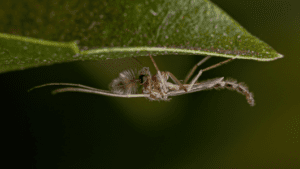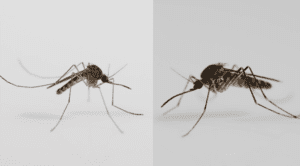Exploring Mosquito Diversity in Your Environment: A Guide to Identifying Adult Mosquito Species


While samples should always be brought into the lab for proper identification when possible, being able to identify the more common mosquitoes in your region is a great skillset to have when working in the field – recognizing patterns in mosquito species can also impact control efforts in real time.
Today, Senior Field Scientist at Clarke, Andrew Rivera, walks through identifying common mosquitoes through their physical characteristics, narrowing down genera to specific species and ultimately enabling filed technicians to link behaviors they observe in the field to these species. In sum, this will cover:
Before we start on identifying adult mosquito species and their genera, a word of caution – look out for imposters!
Mosquito imposters are insects that resemble mosquitoes but belong to different families or groups. When distinguishing between mosquitoes and their imposters, consider factors such as size, body structure, behavior, and habitat. Mosquitoes have specific characteristics like a long proboscis, distinctive markings, and a particular resting posture that can help you differentiate them from other insects, which we’ll cover in the next section.
Crane Flies (Tipulidae): Crane flies are often mistaken for giant mosquitoes but do not bite. They have long, slender bodies and extremely long legs, resembling giant mosquitoes.

Gnats (Various Families): Gnats are small flying insects, sometimes confused with mosquitoes. They can be found in damp soil or decaying organic matter.





Photograph by Ed T. Schmidtmann, USDA/ARS

Looking at the chart above, there’s a lot going on and plenty of small details that can be confusing or too small to see in the field.
Instead, focus on these three key body parts for identifying adult mosquito species: maxillary palpi, tip of the abdomen (cerci), and proboscis. These three components are all you’ll need to be familiar with when navigating through the diverse characteristics of mosquito species from this chart.
A large part of identification is ruling out possibilities and distinguishing between the subtle variations that each mosquito has. Look for key features using markings, wing patterns, antennae and palps structure, unique colorations, mouthparts lengths, and resting positions as indicators of mosquito species.

Different mosquito species thrive in various environments, so understanding a region’s geography and habitats can help begin to narrow down their species possibilities. Understand the environmental factors shaping each species – what temperatures, water types, seasons, and other features they prefer and thrive in.
Group potential candidates based on a single distinguishing feature to lay the foundation for a more detailed exploration into their characteristics. Consider this phase as a strategic way to start funneling mosquitoes into a specific species.

One of the biggest building blocks for being able to easily identify adult mosquitoes in the field by eyesight is being familiar with the common adult mosquito genera.
Look for characteristics distinct of the Aedes, Culex, Anopheles, and Culiseta genera while keeping in mind their habitats and behaviors.
Aedes Species Identification

Culex Species Identification

Anopheles Species Identification

Culiseta Species Identification

With this familiarity with some of the more common adult mosquito genera, you can now run through a simple process to eliminate and identify mosquito species.
Step 1: Anopheles?

Step 2: Pointy Butt?

Step 2a: Aedes or Psorophora?

Aedes (left) Psorophora (right)
Step 3: Something Weird?

Step 4: Culiseta or Culex?

Culex (left) Culiseta (Right)
Once you have a background basis of the common mosquito genera, it’s easy enough to narrow down to a species using their key indicators such as body parts – maxillary palpi, tip of the abdomen (cerci), and proboscis – markings, wings, behavior, and habitats.
When identifying adult mosquitoes in the field, keep in mind the following:
Overall, explore essential features, implement a systematic approach, and incorporate geographical cues to enhance your mosquito identification skills. Happy mosquito spotting!